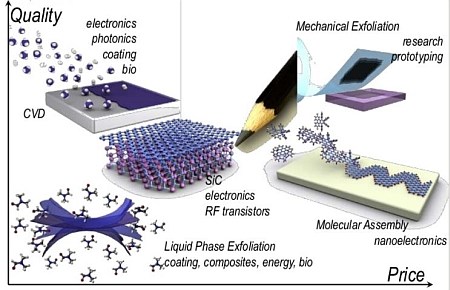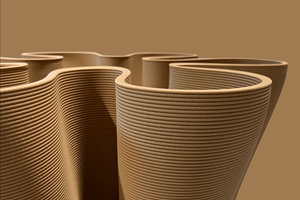Graphene edges closer to widespread production and application
New process may open door for mass production of high-quality nanomaterial targeted to replace copper mesh on composite aircraft.

According to a (slide 12), it would take an elephant balanced on a pencil to break through a sheet of graphene the thickness of cling film. Its development is being targeted for a wide range of composites applications.
A novel process for producing single layer graphene sheets, invented by Cedar Ridge Research (CRR, New Hope, Al, US) chief scientist Larry Fullerton, has received U.S. patent 9,334,168 — the third for its free-floating graphene production technology since 2014. Leveraging the diamagnetism properties of graphene, it synthesizes defect-free monolayer graphene and has the potential to enable volume production of high quality graphene sheets as well as tailoring to meet specific application requirements.
What is Graphene?
As explained by a from the EU project NANOMASTER, graphene is a form of carbon in which the atoms are arranged in ultra-thin sheets just one atom thick. First isolated in 2004, its unique properties have inspired its description as “the ultimate material”.

SOURCE: .
“We’ve seen some exciting properties on a lab scale but we still don’t have a large number of applications for these sorts of materials,” says Ben Hargreaves of the composites consultancy NetComposites Ltd. Hargreaves was coordinator of the EU-funded NanoMaster project, which brought together 13 partners in eight countries to explore using graphene in composites and high-volume manufacturing.
According to the , which dubs itself “The Home of Graphene”, graphene is:
- 200 times stronger than steel, but it is incredibly flexible.
- The thinnest material possible as well as being transparent. Ultra-light yet immensely tough.
- Ultra-light yet immensely tough.
- A superb conductor and can act as a perfect barrier - not even helium can pass through it.
Free Floating Graphene Production Process
CRR’s process for generating a floating continuous graphene film builds upon the traditional chemical vapor deposition (CVD) method. The process involves generating an even plasma distribution to produce a glow discharge of ionized carbon atoms at a desired rate that controls the continuous growth of a graphene film suspended over an alternating polarity magnetic structure. Though the latter must have a sufficient gradient to float graphene in a stable manner, the free-floating growth process requires virtually no raw materials or surface preparation and eliminates the metal etching and transfer issues that lead to efficiency-reducing atomic-scale flaws.
Graphene film produced using this free-floating process can be free of undulations, grain boundaries or defects that may cause uneven build-up of the graphene. The process also enables in-line processing of the graphene during its production to help integrate it into current manufacturing systems for semiconductors, circuit boards and composite materials.

Manufacturing high-quality graphene in high volumes has been an obstacle.
SOURCE: University of Manchester
“Our initial investigations have demonstrated an effective technique to economically produce high quality commercial scale graphene without the use of any growth substrate simply by utilizing the interplay between a magnetic field and the diamagnetic nature of graphene. This permits the growth of pristine defect-free films and alleviates the need to remove a film from a substrate after it has grown to its desired size and shape,” said Fullerton.
CRR President Mark Roberts said this pioneering patent represents “a fundamental capability to produce quality graphene sheets in a scalable and cost efficient manner that did not previously exist.” He added, “We fully expect that this technology will play a substantial role in the wide scale adoption of graphene as the next super material."
Graphene Use in Composites?
One of the first applications being developed, according to an interview published on AZoNano, is to increase the electrical conductivity of epoxy resins in the carbon fiber reinforced plastic (CFRP) fuselages of commercial aircraft in order to get rid of the need for copper mesh as lightning strike protection (LSP).
“The aircraft industry relies heavily on composite materials and lightning strikes pose a big risk as composites tend to be inert and electricity wishes to find an earth,” says Ray Gibbs, CEO of graphene producer (Ammanford, UK) — which acquired EPL Composite Solutions to become (Longborough, Leicestershire, UK). “Copper mesh is currently used in the body of the aircraft,” Gibbs continues. “What we’re looking to do is reduce or remove the copper mesh by having a conductive Faraday cage around the entire aircraft. We are a way off this becoming commercially available today, but it’s potentially a highly lucrative operation.”
Other sources of recent graphene activity in composites include and the . For CW articles on graphene, click here.
Related Content
Sulapac introduces Sulapac Flow 1.7 to replace PLA, ABS and PP in FDM, FGF
Available as filament and granules for extrusion, new wood composite matches properties yet is compostable, eliminates microplastics and reduces carbon footprint.
Read MoreOtto Aviation launches Phantom 3500 business jet with all-composite airframe from Leonardo
Promising 60% less fuel burn and 90% less emissions using SAF, the super-laminar flow design with windowless fuselage will be built using RTM in Florida facility with certification slated for 2030.
Read MorePlant tour: Collins Aerospace, Riverside, Calif., U.S. and Almere, Netherlands
Composite Tier 1’s long history, acquisition of stamped parts pioneer Dutch Thermoplastic Components, advances roadmap for growth in thermoplastic composite parts.
Read MorePlant tour: Teijin Carbon America Inc., Greenwood, S.C., U.S.
In 2018, Teijin broke ground on a facility that is reportedly the largest capacity carbon fiber line currently in existence. The line has been fully functional for nearly two years and has plenty of room for expansion.
Read MoreRead Next
Ultrasonic welding for in-space manufacturing of CFRTP
Agile Ultrasonics and NASA trial robotic-compatible carbon fiber-reinforced thermoplastic ultrasonic welding technology for space structures.
Read MoreCutting 100 pounds, certification time for the X-59 nose cone
Swift Engineering used HyperX software to remove 100 pounds from 38-foot graphite/epoxy cored nose cone for X-59 supersonic aircraft.
Read MoreNext-gen fan blades: Hybrid twin RTM, printed sensors, laser shock disassembly
MORPHO project demonstrates blade with 20% faster RTM cure cycle, uses AI-based monitoring for improved maintenance/life cycle management and proves laser shock disassembly for recycling.
Read More












